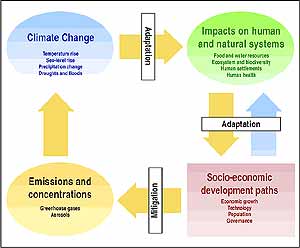 |
| Question 1
What can scientific, technical, and socio-economic
analyses contribute to the determination of what constitutes dangerous
anthropogenic interference with the climate system as referred to in Article
2 of the Framework Convention on Climate Change?
|
 |
 |
| |
|
Natural, technical, and social sciences can provide
essential information and evidence needed for decisions on what constitutes
"dangerous anthropogenic interference with the climate system."
At the same time, such decisions are value judgments determined through
socio-political processes, taking into account considerations such as development,
equity, and sustainability, as well as uncertainties and risk.
|
 Q1.1
Q1.1 |
The basis for determining what constitutes "dangerous
anthropogenic interference" will vary among regions -- depending
both on the local nature and consequences of climate change impacts, and
also on the adaptive capacity available to cope with climate change -- and
depends upon mitigative capacity, since the magnitude and the rate of change
are both important. There is no universally applicable best
set of policies; rather, it is important to consider both the robustness
of different policy measures against a range of possible future worlds,
and the degree to which such climate-specific policies can be integrated
with broader sustainable development policies.
|
 Q1.2
Q1.2 |
The Third Assessment Report (TAR) provides an assessment
of new scientific information and evidence as an input for policymakers
in their determination of what constitutes "dangerous anthropogenic
interference with the climate system." It provides, first,
new projections of future concentrations of greenhouse gases in the
atmosphere, global and regional patterns of changes and rates of change
in temperature, precipitation, and sea level, and changes in extreme
climate events. It also examines possibilities for abrupt and irreversible
changes in ocean circulation and the major ice sheets. Second, it provides
an assessment of the biophysical and socio-economic impacts of climate
change, with regard to risks to unique and threatened systems, risks
associated with extreme weather events, the distribution of impacts,
aggregate impacts, and risks of large-scale, high-impact events. Third,
it provides an assessment of the potential for achieving a broad range
of levels of greenhouse gas concentrations in the atmosphere through
mitigation and information about how adaptation can reduce vulnerability.
|
|
An integrated view of climate change
considers the dynamics of the complete cycle of interlinked causes and
effects across all sectors concerned (see Figure
SPM-1). The TAR provides new policy-relevant
information and evidence with regard to all quadrants of Figure
SPM-1. A major new contribution of the Special Report on Emissions
Scenarios (SRES) was to explore alternative development paths and
related greenhouse gas emissions, and the TAR assessed preliminary work
on the linkage between adaptation, mitigation, and development paths.
However, the TAR does not achieve a fully integrated assessment of climate
change because of the incomplete state of knowledge.
|
|
Climate change decision making
is essentially a sequential process under general uncertainty.
Decision making has to deal with uncertainties including the risk of non-linear
and/or irreversible changes and entails balancing the risks of either
insufficient or excessive action, and involves careful consideration of
the consequences (both environmental and economic), their likelihood,
and society's attitude towards risk.
 |
Figure
SPM-1: Climate change - an integrated framework. Schematic
and simplified representation of an integrated assessment framework
for considering anthropogenic climate change. The yellow arrows
show the cycle of cause and effect among the four quadrants shown
in the figure, while the blue arrow indicates the societal response
to climate change impacts. See the caption for Figure
1-1 for an expanded description of this framework. |
|
|
The climate change issue is part of the larger challenge
of sustainable development. As a result, climate policies can be more effective
when consistently embedded within broader strategies designed to make national
and regional development paths more sustainable. This occurs because
the impact of climate variability and change, climate policy responses,
and associated socio-economic development will affect the ability of countries
to achieve sustainable development goals. Conversely, the pursuit of those
goals will in turn affect the opportunities for, and success of, climate
policies. In particular, the socio-economic and technological characteristics
of different development paths will strongly affect emissions, the rate
and magnitude of climate change, climate change impacts, the capability
to adapt, and the capacity to mitigate.
|
 Q1.9-10
Q1.9-10 |
The TAR assesses available information on the timing,
opportunities, costs, benefits, and impacts of various mitigation and
adaptation option. It indicates that there are opportunities
for countries acting individually, and in cooperation with others, to
reduce costs of mitigation and adaptation and to realize benefits associated
with achieving sustainable development.
|
 Q1.11
Q1.11
|
|
|

